As soon as FC Cincinnati fans get the opportunity to fill TQL Stadium to the brim, they’re going to. There will only be about 6,000 season-ticket holders in attendance for the stadium’s inaugural match on Saturday (4 pm ET | FOX, FOX Deportes) against Inter Miami CF, but when full capacity becomes feasible, 26,000 people will fill the league’s third-largest and perhaps most resplendent soccer-specific stadium. It won’t be surprising.
In 2018, the club averaged 25,717 fans each match. In 2018, the club still played in the USL. When Cincinnati joined MLS in 2019, they bumped that average attendance a little higher. 27,336 regularly attended matches at Nippert Stadium, their old stomping grounds. The bump in attendance continued a trend from their inaugural USL season in 2016, when a little over 17,000 came through the gates each game. Numbers rose each year after that.
They own almost every single USL ticket record you can think of. They regularly outdrew MLS teams, which is amazing considering they were playing at a lower level of soccer. And then they made the jump to MLS and still drew even more fans despite enduring a painful first season on the pitch. The team were again stuck to the foot of the standings in 2020 and yet the fanbase is still rearing to go to its new stadium.
The quality on the field and the quantity in the stands have led to a pretty consistent set of questions from outsiders around the league, namely “How?” And, “Are you OK?”
It’s a strange place to be in for a Cincinnati supporter right now. The owners are clearly invested in creating a product worthy of the fanbase. TQL Stadium — which, by all accounts, is a new standard-bearer for soccer-specific stadiums in the US — and offseason investments such as the club’s new 21-year-old Brazilian striker, Brenner, show that intent. But we’re entering Week 5 of year three in MLS and FC Cincinnati are once again in last place in the league by points and goal differential.
It’s frustrating. The good news, though, is that the fan base seems to have been built out of itself. It’s been solidified and grown through a self-sustaining ecosystem that isn’t going to go away with a couple of bad seasons.
Around 14,000 showed up to the club’s inaugural match in USL. That’s an impressive number, but inaugural events of any kind are shiny things that usually attract people that come and go. Instead, the atmosphere brought people back which created a better atmosphere for the next game and the game after that and then suddenly you looked up and 32,500 or so are showing up to watch a US Open Cup match against Chicago.
“It kind of just seemed like going into it that it was one of those fun things we may have for a couple of years, and it might just fade into the distance, but from the moment Sean Okoli scores the opening goal, you could see the reaction to that and the passion and how many people actually showed and how many people were actually into it,” Travis Grimes, an FCC supporter and co-host of 'You Ain’t Lion,' an FCC-based podcast said.
“It just seemed that everybody was on bated breath with every pass and every shot. It was just kind of immediate. It was kind of odd. There were already chants and there was already fan engagement and it was just organic from the beginning.”

"Everything about it felt special"
It’s difficult to pinpoint exactly how you have an environment like that pop up from the very beginning for a team whose stakes are inherently lower than other clubs around the continent. Some pointed to the club’s willingness to simply try to win and engage fans from the very beginning as a reason for the team resonating with a city that defines itself as blue-collar. Some pointed to the hope that comes with a new team when the Reds (MLB) and Bengals (NFL) have struggled for so long. And some pointed out that people just love any excuse to party.
The truth is probably some combination of those things and some smaller details you wouldn’t understand unless you’re a native. You don’t have to be a born and raised Cincinnatian (Cincinnatite?) to understand that it’s special, though.
For example, Kaylor Hodges reached out for this piece willing and eager to talk about FC Cincinnati. Kaylor Hodges is from Birmingham, Alabama. He has family in the area but it’s not just a passing support for a team with family ties. He’s traveled to multiple matches each season.
“Everything about it felt special. Even if the team was not great," Hodges said. “But going and being a part of the supporters’ groups and being a part of that atmosphere, it just really made me feel something I haven't felt in sports in America.”
Those supporters’ groups helping create that atmosphere through chants and tifo on The Bailey have played an obvious role in turning matchday into an event that keeps the fanbase growing. However, they also offer another glimpse into why that fanbase exists as it does. Groups like Die Innenstadt take their name and branding from the city’s German heritage, while The Briogáid (pronounced “brigade”) does the same with the city’s Irish heritage. These groups and the club as a whole offer a chance to show a love for Cincinnati that other sports may not offer and others from outside the city may not expect.
“That's one of the things with all the groups collectively that has really spoken to people. No matter what group you're joining, we're all pushing the same message of civic pride in Cincinnati,” said Jared Handra, president of Die Innenstadt. “We’re not the biggest city. We're not the most successful city in sports or other terms, too. We're not a metropolis. We're not New York, We're not LA. And I think everyone really loves that about Cincinnati. This is a way to kind of express that.”
That expression happens through art and songs and other bits and pieces of the city as a whole that have been incorporated into the ecosystem that sustains FC Cincinnati fanhood at even the lowest of points.
“There's a lot of heartburn about, ‘Oh crap, is, this is going to be another 30-year struggle where we never make playoffs and all this kind of stuff. There's definitely that because Cincinnatians, we’re familiar with that atmosphere,” Colin Hill, president of The Briogáid said.
“But I think the difference with FC Cincinnati is it's become such a cultural piece. We have the pubs involved. We have the breweries involved. There’s Washington Park where we go before going to the stadium. There’s that imagery of Music Hall. There's a lot of art and culture connected with the FC Cincinnati scene that you don't necessarily see with the other professional sports teams in town.”
Embracing the struggle with better times ahead
Unfortunately, for all the culture and architecture of Cincinnati, there’s another piece of imagery associated with the team. For now anyway. It’s a wooden spoon. The trophy handed to the supporters of the team that finish dead last in each MLS season since 2015. It’s been in Cincinnati for the last couple of years. More specifically, it’s currently at Jared Handra’s house. A hastily thrown together piece of assorted wood with a wooden spoon nailed to the front and tiny plaques representing each winner of the trophy. It likely doesn’t tie the room together.

It’s a piece of the FCC culture, though. For now. And all you can really do is embrace it and recognize two things: There’s community to be found in the struggle and when this team stops struggling, this fanbase is going to celebrate like few in this league have.
“I'm taking that with me to the first game. People eat it up. It's hilarious. Like people, I saw people walking around at the meet your seat event with wooden spoons. People are embracing it a little bit,” Handra said. “I think that actually helps a lot in the future. There’s nothing we can do but laugh, right? Have some fun with it. And I think going forward, if we can be the fanbase that makes a funny situation out of nothing, I think we're better for it.”
Eventually, the team itself will come good. Like one FC Cincinnati fan pointed out, even Orlando eventually came good. If you have the support and ownership is willing to invest, you can’t stay down for too long. The new stadium in the West End is a part of that. It’s a piece of the club worthy of the legions that support it, even if the team isn’t quite there yet.
Until then, Cincy fans will just have to keep speaking loudly and carrying a tiny spoon. That’s all they can do. Try to continue growing a fanbase that created itself and appreciate that it can’t be bad for too long. And even if it is, the community isn’t going anywhere.
“I think the culture is going to sustain. We put the stadium in the right place. That OTR Western area has been the cultural epicenter of the city for the last five to 10 years as it's experienced unbelievable development,” Hill said.
“If the team plays well there, great. If they don't, you're still going to have a boatload of people down there every Saturday and Sunday when we have games just to take it all in. Just to be a part of it.”













